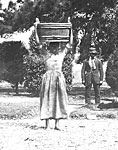|
Digital History>Teachers>Modules>Slavery
Learn About
Slavery

 Beginning at least as early as 1502, European slave traders shipped approximately 11 to 16 million slaves to the Americas, including 500,000 to what is now the United States. By the beginning of the eighteenth century, slaves could be found in every area colonized by Europeans.
Initially, English colonists relied on indentured white servants, but by the late seventeenth century, faced with a shortage of servants, they increasingly resorted to enslaved Africans. Beginning at least as early as 1502, European slave traders shipped approximately 11 to 16 million slaves to the Americas, including 500,000 to what is now the United States. By the beginning of the eighteenth century, slaves could be found in every area colonized by Europeans.
Initially, English colonists relied on indentured white servants, but by the late seventeenth century, faced with a shortage of servants, they increasingly resorted to enslaved Africans.
Three distinctive systems of slavery emerged in the American colonies. In Maryland and Virginia, slavery was widely used in raising tobacco and corn and worked under the "gang" system. In the South Carolina and Georgia low country, slaves raised rice and indigo, worked under the "task" system, and were able to reconstitute African social patterns and maintain a separate Gullah dialect. In the North, slavery was concentrated on Long Island and in southern Rhode Island and New Jersey, where most slaves were engaged in farming and stock raising for the West Indies or were household servants for the urban elite.
The American Revolution had contradictory consequences for slavery. Thousands of slaves freed themselves by running away. In the South, slavery became more firmly entrenched, and expanded rapidly into the Old Southwest after the development of the cotton gin. In the North, in contrast, every state freed slaves by statute, court decision, or enactment of gradual emancipation schemes.
During the decades before the Civil War, slave grown cotton accounted for over half the value of all United States exports, and provided virtually all the cotton used in the northern textile industry and 70 percent of the cotton used in British mills. The slave South failed to establish commercial, financial, or manufacturing companies on the same scale as the North.

 Slavery dates to prehistoric times and could be found in ancient Babylon, classical Greece and Rome, China, India, and Africa as well as in the New World.
Thomas Jefferson, James Madison, and George Washington were slaveholders. So, too, were Benjamin Franklin and the theologian Jonathan Edwards. John Newton, the composer of "Amazing Grace," captained a slave ship early in his life. Robinson Crusoe, the fictional character in Daniel Defoe's famous novel, was engaged in the slave trade when he was shipwrecked. Slavery dates to prehistoric times and could be found in ancient Babylon, classical Greece and Rome, China, India, and Africa as well as in the New World.
Thomas Jefferson, James Madison, and George Washington were slaveholders. So, too, were Benjamin Franklin and the theologian Jonathan Edwards. John Newton, the composer of "Amazing Grace," captained a slave ship early in his life. Robinson Crusoe, the fictional character in Daniel Defoe's famous novel, was engaged in the slave trade when he was shipwrecked.
Slavery has often been treated as a marginal aspect of history, confined to courses on southern or African American history. In fact, slavery played a crucial role in the making of the modern world. Slavery provided the labor force for the Slavery played an indispensable role in the settlement and development of the New World.
In the decades before the Civil War, a third of the South's population labored as slaves. Enslaved African Americans performed all kinds of work, but slavery mainly meant backbreaking field work. Deprivation and physical hardship were the hallmark of life under slavery. Slave sales frequently broke up slave families. Nevertheless, enslaved African Americans were able--through their families, religion, and cultural traditions--to sustain an autonomous culture and community beyond the direct control of their masters. In addition, slaves resisted slavery through insurrection and a variety of indirect protests against slavery.
Read more about slavery
Historiographical Essay on Slavery
(Opens in a new window; close that window to return here)

American Slavery As It Is by Theodore Dwight Weld, 1839
(Opens in a new window; close that window to return here)
More documents in the our collection.
(Opens in a new window; close that window to return here)

Handouts and fact sheets:
Slavery
Slavery Fact Sheets
(Opens in a new window; close that window to return here)
Recommended
lesson plan:
Slavery and the Making of America
(Opens in a new window; close that window to return here)
Quizzes:
Quiz on Slavery, Answers to the Quiz on Slavery
(Opens in a new window; close that window to return here)

 Recommended books:
Recommended books:
Essential books:
- Ira Berlin, Many Thousands Gone: The First Two Centuries of Slavery in America
- Peter Kolchin, American Slavery
More books on slavery
Other resources on slavery
(Opens in a new window; close that window to return here)
 Recommended
film: Recommended
film:
 Glory Glory
The heroic story of the 54th Massachusetts Volunteer Regiment, the first black regiment to fight in the Civil War.
Many influential Hollywood films, from Birth of a Nation and Gone with the Wind to Glory and Amistad, have helped shape the way Americans have thought about slavery.
Learn more about inaccuracies in Hollywood's depictions of slavery
(Opens in a new window; close that window to return here)
 Recommended
Website: Recommended
Website:
Virginia Runaways
A digital database of runaway and captured slave and servant advertisements from 18th-century Virginia newspapers, this project offers full transcripts and images of all runaway and captured ads for slaves, servants, and deserters placed in Virginia newspapers from 1736 to 1790
http://people.uvawise.edu/runaways/index.html
(Opens in a new window; close that window to return here)
|
